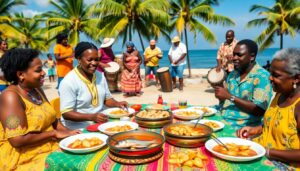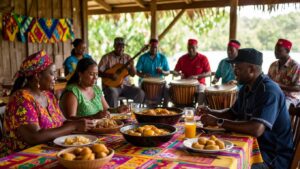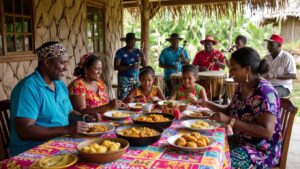Unveiling the Rich Tapestry of Garifuna Culture in Belize: Heritage, Culinary Adventures & Unique Experiences
The Garifuna community in Belize showcases a dynamic blend of African, Indigenous Caribbean, and European influences, resulting in a distinctive cultural legacy celebrated worldwide and acknowledged by UNESCO. This vibrant heritage is reflected in various aspects such as their unique language, captivating music, delectable cuisine, lively dance forms, rich spiritual traditions, and a profound sense of community. This comprehensive guide takes you on an engaging journey through the enchanting narrative of the Garifuna in Belize, highlighting their rich history, enduring traditions, colorful festivals, and the thriving cultural hub of Hopkins Village.
Diving Deep into the Garifuna Heritage
The Garifuna people are renowned as one of the most prominent cultural groups in Belize, with ancestry rooted in West and Central African heritage alongside the Indigenous Caribs and Arawaks. Their story took a significant turn in 1797 when they resisted colonial powers in St. Vincent, leading to their forced exile to Central America. Currently, the Garifuna population in Belize is about 30,000, making substantial contributions to the cultural mosaic of southern Belize through their distinctive language, exceptional cuisine, vibrant art, and cherished customs. Recognized as a Masterpiece of the Oral and Intangible Heritage of Humanity by UNESCO, their resilient spirit, creativity, and adaptability thrive within communities like Dangriga, Hopkins, Seine Bight, and Punta Gorda, as well as in diaspora groups across the Americas. The annual celebration of Garifuna Settlement Day on November 19 serves as a powerful reminder of their story of resilience, community, and rich cultural heritage.

Uncovering the Historical Foundations of the Garifuna Community
Tracing the Ancestral Roots of African and Carib Heritage
The story of the Garifuna begins in the 17th century, marked by the extraordinary convergence of African survivors from two Spanish slave ships and the Indigenous Carib and Arawak populations of St. Vincent in the Lesser Antilles. Over a period exceeding 150 years, intermarriage and cultural exchanges birthed a unique Afro-Indigenous identity known as the Garinagu. This identity is characterized by a rich spectrum of traditions, languages, and practices that vividly reflect their diverse ancestral heritage and experiences.
Forced Migration and New Beginnings in Belize
In 1797, after exhibiting fierce resistance against British colonial forces, approximately 5,000 Garifuna were forcibly exiled from St. Vincent to Roatán, Honduras. This marked the onset of migrations along the Central American coastline, establishing vibrant Garifuna communities in southern Belize by the early 19th century. Key cultural hubs like Dangriga, recognized as the cultural capital, along with Hopkins, Seine Bight, and Barranco, emerged during this period. The British authorities encouraged these migrations as they sought skilled laborers adept in fishing and agriculture, further facilitating the growth of these communities.
Cultural Resilience and Continuity Amidst Challenges
Despite facing numerous adversities due to European colonization, land dispossession, and systemic discrimination, the Garifuna have remarkably preserved their language, social structures, and rich spiritual traditions. The establishment of the National Garifuna Council in 1981 has been instrumental in advocating for cultural rights and educational opportunities, ensuring that the Garifuna heritage continues to be honored and celebrated.
The Crucial Role of Language and Identity in Garifuna Culture
Distinctiveness of the Garifuna Language
The Garifuna language stands out as an Arawakan language enriched with Carib and African loanwords, making it an exceptional linguistic representation among Central American languages. Its structure includes gendered pronouns and a complex tense system, alongside a wealth of oral traditions that encapsulate the community's historical narrative and cultural values. However, the survival of the Garifuna language faces significant threats from language shift due to migration and urbanization, with less than 15,000 Belizean Garifuna individuals remaining fully fluent in their native tongue.
Efforts for Revitalization and Language Preservation
The recognition of the Garifuna language and music as an Intangible Heritage by UNESCO in 2001 has sparked revitalization initiatives. In communities such as Hopkins and Dangriga, educational programs in Garifuna have been integrated into primary schools, while community radio stations play music and disseminate news in the language to help sustain its vitality. Organizations like GAMAE International have also initiated language immersion summer camps designed to reconnect youth with their ancestral roots and linguistic legacy.
Expressions of Identity and Connections within the Global Diaspora
The Garifuna identity is reinforced through traditional clothing, ancestral lineage, clan symbols, and unique naming customs. This identity is actively nurtured by cultural associations both within Belize and in diaspora communities located in major urban centers like New York, Los Angeles, and London, where they continue to honor and celebrate their rich heritage.
Experiencing the Energetic World of Garifuna Music and Dance
The Spiritual Importance of Rhythmic Drumming
Garifuna music is renowned for its intricate rhythmic patterns, seamlessly blending traditional African polyrhythms with indigenous chants. The drums, particularly the primero (tenor) and segunda (bass), play a central role in many spiritual ceremonies and festive events. For example, the sacred dugú ceremony involves drum circles and ancestral invocations that aim to heal or bless families, highlighting the profound connection between music and spirituality within Garifuna culture.
Dynamic Dance Forms: Punta and Punta Rock
Among the most cherished Garifuna dance styles is the punta, noted for its rapid hip movements and intricate footwork, typically accompanied by call-and-response singing and vibrant percussion. The contemporary evolution of this dance style, referred to as punta rock, has gained popularity through distinguished musicians such as Andy Palacio and Pen Cayetano, who ingeniously blend traditional rhythms with modern instrumentation, successfully introducing Garifuna culture to wider audiences globally.
Cultural Festivals: A Celebration of Community and Heritage
In the lively towns of Hopkins and Dangriga, dance troupes frequently perform during cultural festivals and for visiting tourists, forging a vibrant link between generations. These performances not only celebrate the Garifuna heritage but also serve as a crucial economic resource for the community, fostering tourism and cultural exchange.

Insights into Garifuna Cultural Practices and Spiritual Beliefs
Understanding the Significance of the Dugú Ceremony
The dugú ceremony is a multi-day event in which extended families gather to honor the spirits of their ancestors, known as gubida. Led by a spiritual healer, or buyei, this ceremony incorporates music, dance, and communal feasting, all aimed at restoring harmony within families and the community at large. It underscores a deep respect for the land, ancestral heritage, and collective responsibilities.
Everyday Life Interwoven with Spiritual Beliefs
The spiritual beliefs of the Garifuna reflect a unique amalgamation of Catholicism intertwined with African and Arawak cosmologies. Daily life is punctuated by various rituals that include blessings for new buildings, rites of passage for births and deaths, and agricultural celebrations. Significant symbols, such as the conch shell, sea turtle, and cassava, serve as vital connections between households and the natural world, as well as the ancestral spirits.
Delving into the Culinary Treasures of Garifuna Gastronomy
Key Culinary Staples and Signature Dishes
The culinary landscape of Garifuna culture is deeply anchored in staples such as cassava (or yuca), plantains, coconut, and an abundance of fresh seafood. Among traditional offerings, ereba, a cassava bread made from grated cassava pressed and toasted over an open fire, stands out. Another signature dish, hudut, features fish simmered in creamy coconut milk, served alongside mashed green and ripe plantains. Other favorites include machuca, a hearty fish soup with garlicky, mashed plantain dumplings, and tapou, a savory seafood stew infused with coconut milk. In bustling street markets in Hopkins and Dangriga, visitors can indulge in local delights such as cassava pone (a sweet cake), fried plantain balls (known as ganún), and refreshing conch ceviche.
Championing Sustainable Culinary Practices
Traditional Garifuna practices like seasonal fishing, shellfish gathering, and small-scale gardening advocate for ecological stewardship. These practices are informed by cultural taboos and communal resource management principles. Culinary festivals in Hopkins feature cooking competitions and food tours organized by women’s cooperatives, ensuring the preservation of cherished recipes and cooking techniques while actively engaging visitors in the rich gastronomic heritage of the Garifuna.
Hopkins Village: The Heartbeat of Garifuna Culture
A Glimpse into Historical Background and Cultural Significance
Established in the early 1800s, Hopkins, known as Yarumein in Garifuna, is located along the stunning Stann Creek coast. It serves as a vital center for the Garifuna language, music, and crafts, embodying the rich cultural legacy of the community and its traditions.
Essential Experiences Not to Miss in Hopkins
- Engage in Drum Circles: Participate in daily drum schools and enjoy nightly drum circles at local cultural centers.
- Visit the Garifuna Museum: Explore an array of artifacts, oral histories, and photographic archives that delve into the community's migration, language, and music.
- Homestays and Workshops: Interact with local families offering cooking lessons, fishing trips, and demonstrations of cassava bread making.
Annual cultural events in Hopkins, particularly the youth pageants during Garifuna Settlement Day, position the village as an authentic gateway to experiencing the vibrant cultural tapestry of Garifuna Belize.
The Economic Impact of Cultural Tourism
Cultural tourism is a vital economic driver in Hopkins, supporting over 75% of local households through guest accommodations, handicrafts, music instruction, and guided tours. The headquarters of the National Garifuna Council coordinates regional festivals and advocacy initiatives, ensuring that Garifuna culture remains dynamic and visible to the world.
Honoring Garifuna Settlement Day: A Celebration of Cultural Heritage
The Historical Importance of Settlement Day
Since 1941, Garifuna Settlement Day has been celebrated every November 19, and it became nationally recognized in 1977. This pivotal day commemorates the historic arrival of Garifuna ancestors in Belize by canoe in 1802. The reenactment procession, known as Yurumein, sees villagers arriving ashore with drums, cassava, and crops while joyously singing and praying, symbolizing their enduring legacy.
Modern Celebrations and Festivities
The festivities surrounding Garifuna Settlement Day beautifully intertwine sacred and secular elements, featuring all-night dugú ceremonies and continuous drumming in churches and community squares. Processions adorned in traditional attire, lively parades, dance performances, and food fairs mark the occasion. National broadcasts, media features, and diaspora celebrations in major US cities attract visitors from across Belize and beyond, enhancing awareness and appreciation for Garifuna cultural traditions.
Navigating Contemporary Challenges and Preserving Cultural Heritage
The Language Shift Among Younger Generations
Language shift represents a critical challenge for the Garifuna community, as many young individuals, particularly in urban areas, increasingly speak English or Kriol at home. This concerning trend has been recognized by UNESCO, prompting schools and NGOs to implement language immersion programs, radio broadcasts, and mentorship initiatives aimed at preserving linguistic heritage and cultural identity.
Challenges of Land Rights and Tourism Development
The rapid growth of tourism and real estate development in coastal areas such as Seine Bight and Hopkins threatens the traditional landholdings of the Garifuna. Advocacy efforts from the National Garifuna Council and collaborative NGOs focus on securing land rights, influencing urban planning, and ensuring that tourism revenues benefit local families and communities.
Involving Youth through Arts, Technology, and Diaspora Links
Garifuna artists and musicians, both locally and within the diaspora, are actively engaged in recording music, documenting recipes, and preserving oral histories to create digital archives and virtual festivals. These contemporary platforms play a crucial role in fostering connections between the broader Garifuna community and younger generations, ensuring that their rich cultural heritage is both maintained and celebrated.
Guidelines for Experiencing Garifuna Culture Responsibly
- Opt for accommodations in Hopkins, Dangriga, or Seine Bight, and book tours directly through Garifuna-owned establishments to positively impact the local economy.
- Engage in a drum workshop, attend a Settlement Day celebration, or volunteer for local cultural preservation efforts to fully immerse yourself in the culture.
- Support women’s cooperatives by sampling traditional dishes or purchasing handcrafted goods to promote sustainable livelihoods.
- Always honor local customs; seek consent before taking photographs of individuals and remain respectful during rituals and ceremonies.
- Learn a few basic phrases in the Garifuna language to show your respect and genuine interest in the culture.
The Garifuna culture in Belize represents a vibrant tapestry woven with resilience, profound spirituality, infectious music, delightful culinary offerings, and strong community connections. By visiting destinations like Hopkins or Dangriga, engaging in local festivals, or immersing oneself in the rhythmic pulse of the drums, travelers are presented with a unique opportunity to connect with a rich historical continuum where the past and present harmoniously resonate. Supporting Garifuna-owned businesses, honoring their traditions, and celebrating the linguistic and culinary diversity of this remarkable culture are essential steps towards ensuring its survival and flourishing for future generations.
References and Further Reading for Deepening Your Understanding
- Language, Dance and Music of the Garifuna – UNESCO Intangible Heritage
- History Of The Garifuna People – Belize.com
- Garifuna people – Wikipedia
- Varner, G.R. “Native Status and Maya Identity in Belize.” Journal of Latin American Anthropology, 1998
- Lee, N.R. “Toledo Garifuna and Indigenous Rights.” Mesoamerican Research, 2022
- National Garifuna Council – Wikipedia
- The Garifuna Living Heritage – ICH NGO Forum, 2023
- Dinther, R. “Language Shift and Prestige: Garifuna in Hopkins.” Journal of Pidgin and Creole Languages, 2017
- Habinaha Garifuna Language Program
- Veal, T. “Africanisms in Garifuna Culture of Belize.” Cultural Anthropology, 2004
- National Geographic: Preserving Garifuna Identity Through Ritual
- Music In Africa: Punta Rock and Garifuna Music
- Hopkins Cultural Center Official Site
- Cultural Survival Quarterly: Maya Rainforest and Garifuna in Belize
- Belize Living Heritage: Rituals and Social Practices
- Texas A&M: Belizean Food Culture
- Love Your Belize: Hudut Recipe
- Global M&A Pages: Sustainable Fishing Cooperatives
- National Garifuna Council of Belize
- UN Sustainable Development Reports on Garifuna Cultural Tourism
- Ambergris Caye: Garifuna Settlement Day Celebrations
- Garifuna.com: Diaspora, Digital Storytelling, and Modern Initiatives
The Article Garifuna Culture in Belize: Heritage, Food & Where to Experience It appeared first on Belize Travel Guide
The Article Garifuna Culture: Experience Heritage and Cuisine in Belize Was Found On https://limitsofstrategy.com


